Budgeting Tab
Introduction

Accounting Software accounts balances budgeting budgeting
The Budget tab is used to enter a projected 12 month budget for one or more accounts.
Creating and Editing Your Budget
Click on the Create a new budget button  on the toolbar.
on the toolbar.
On the left hand side of the screen you will see your Accounts. Open all the account groups to see everything. You do not need to enter a budget for every single account, nor do you need to fill in every single field.
There are a variety of ways to enter data.
- Click in the Total box of any account or account group.
- Click in one of the Month cells for any account or group and set the budget just for that period.
- You can also enter formulae. For example type ‘=12#700’ (without the quotation marks) in the Total field of any account. This will autocalculate and enter 8400.00 equally across the 12 month period.
Editing your Budget
If you need to edit the data you have entered, there are the following options:
- Click in the cell you wish to edit the data for. If you adjust an individual period, the Total for that account will change to Red to show there is an imbalance. To have it auto-fix the total, click the Tick button in the toolbar.
- You can also change the period values as a percentage of the total – i.e. if you know that your sales fluctuate higher in October, November and December, and lower in January, February and March.
You can also view your data as integers or to two decimal places. To toggle between the two options, click the control whether pence values are displayed icon.
Click on the Edit budget button on the ‘Budget Toolbar’ to bring up the ‘Edit Budget Properties’ dialogue. Here you can change the name or archive the budget.
Archive budget - It is recommended that you archive a budget if you no longer wish to use it.
Tool Bar
The tool bar consists of:
Select Budget

Accounting Software business budgeting drop down
This drop down box allows you to pick which budget (you may have some from past years) to view/edit.
The ‘pad lock’ symbol by the name of the budget denotes if the budget has been Locked.
Create a New Budget

Accounting Software button add
Click this button to create a new budget. After clicking this button the ‘Create a new Budget’ pop-up will appear:

Accounting Software business budgeting create new
Here you can set the:
- Budget Name - the given name for the budget
- Start Date - the date for the start of your financial year
Edit Budget

Accounting Software button edit
Click this button to edit the current budget. After clicking this button the ‘Edit Budget Properties’ pop-up will appear:

Accounting Software business budgeting edit
Here you can edit the:
- Budget Name - the given name for the budget
- Archive budget - allows you to archive/un-archive the budget
Archiving Budgets
Archiving budgets is a way of hiding unwanted budgets from the budget drop down selector.
If you have archived one or more budgets you will see a new item appear at the bottom of the budget drop down selector. You will see either:
- ###Show archived Budgets### - this item means that your archived budgets are currently hidden from view. Clicking on this option will cause the archived budgets to be shown.
- ###Hide archived Budgets### - this item means that your archived budgets are currently visible. Clicking on this option will cause the archived budgets to be hidden from view.
If you see neither of these two items then you have no archived budgets to show or hide.
Show or Hide decimal point

Accounting Software button show hide decimal
Clicking on this button will cause the figures after the decimal point to be hidden/displayed in the Budget Table.
Delete ‘Specified’ Value

Accounting Software button delete
Clicking on this button will delete the value of the currently selected cell in the Budget Table if it is not a calculated value.
Replace Specified Value with Calculated Value

Accounting Software button budgeting set total value to sum of child accounts
Clicking on this button will replace the user specified value of the currently selected cell in the Budget Table with the calculated ‘sum’ value.
If the button is disabled then the selected cell is already equal to the calculated ‘sum’.
Adjust Period Values by Percentages

Accounting Software button budget percentage
Click this button to adjust the period values for the currently selected row. After clicking this button the ‘Set Period Values as a Percentage of Total’ pop-up will appear:

Accounting Software creating a budget geting set total value to sum of child accounts
The ‘Set Period Values as a Percentage of Total’ pop-up shows the amounts for all the individual periods along the top and the individual period’s values as a percentage of the total . along the bottom.
Each period has a ‘slider’ that allows you to increase or decrease the percentage of total value for the given period. As you move the slider up the percentage of total value for that period will increase as all the other periods decrease (and vise-versa).
As soon as you edit a period’s percentage value (either by using the slider or editing the percentage figure directly) that period will become locked. Locking a period means that its percentage value will not be altered when you adjust another period’s value (which is useful when you want to precisely set two or more period’s values). You can lock and unlock periods via the check box above each period’s slider bar.
There are four buttons on the far right of the ‘Set Period Values as a Percentage of Total’ pop-up, these are:
- Evenly Distribute - will evenly distribute the total amount amongst all periods (overrides any period locks)
- Apply - set the current period values into the budget and closes the pop-up.
- Reset - reverts the period values back to what they were when the pop-up first opened.
- Cancel - disregards the current period values and closes the pop-up.
Show Budget
This drop down box enables you to select from the following filters which are applied to the Budget Table:
- Show Budget - displays the total/monthly budgets set against each account, as applicable.
- Show Actuals - displays the actual year/monthly net totals for money received into/taken out of each account.
- Show Diff - displays the difference between budget and actual totals as per the above.
Print Budget

Accounting Software button print
Clicking on this button will take you to the Document Editor from where you can design and print the data currently being displayed in the Budget Table.
Export Budget to CSV

Accounting Software button csv export
Clicking on this button will bring up a ‘file save’ dialogue asking you to specify the name and location of the CSV file you wish to create. This file will contain all the data currently being displayed in the Budget Table.
Budget Table

Accounting Software creating a budget get table
The ‘Budget Table’ is linked with the ‘Accounts’ tree panel on the far left of the screen. Each row in the budget table corresponds to an account in the ‘Accounts’ tree panel.
This is best illustrated by expanding and contracting the account groups in the ‘Accounts’ tree panel, as you do this you will see that the number of rows shown in the budget table grow/shrink to match the number of accounts in the ‘Accounts’ tree panel.
The ‘Budget Table’ always consists of 13 columns, 12 periods and one total column. The first column represents the total yearly budget figure for the corresponding account.
Total Column
The total column always represents the sum of its corresponding 12 periods.
Entering a value in the ‘Total’ column will cause this value to be distributed amongst each of the 12 periods (either evenly distributed if no values currently exist for any of these periods, or distributed using the existing weightings of the period column’s current values).
Period Columns
The 12 period values for the lowest level (child) accounts in the ‘Accounts’ tree panel must be explicitly set by the user (either by manually setting each period value or setting a value in the total column that is automatically distributed amongst the 12 periods).
The 12 period values for an account group in the ‘Accounts’ tree panel automatically displays the total sum value for all its child values of the same period. The period values for a group account can be explicitly set by the user (to override the default calculated value) but the system will warn you if the explicitly set value does not match the calculated sum value by turning the cell red.
Error (Red) Cells
A cell that has a red background indicates that the value in this cell does not match the calculated sum of all its child values.
To quickly resolve this issue you can select the cell in error and then press the tick icon in the tool bar to correct the value to is expected amount.
